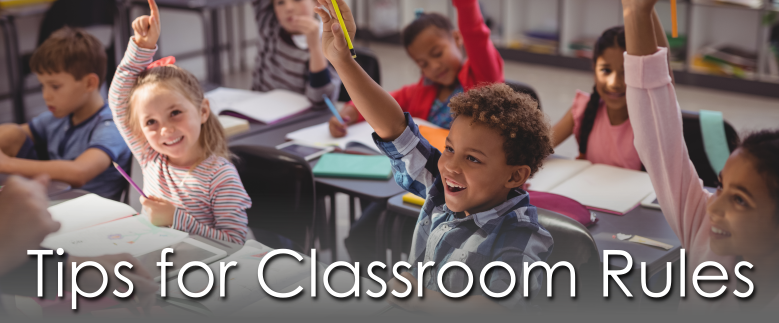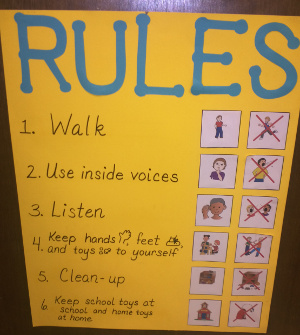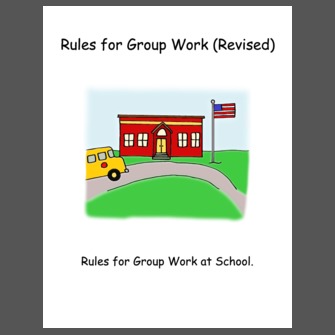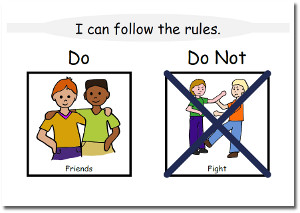
Tips for Creating Classroom Rules
Classrooms management and discipline is an important piece of creating a positive learning environment. At the beginning of the year, most teachers discuss and brainstorm a list of classroom rules and compile them into a set of 4-6 rules to display in the classroom. There are some important points to keep in mind as you and your class work through this beginning of the year ritual.
Older students can understand rules such as "Be cooperative" or "Respect others" while younger children need more concrete language such as "Keeps Hands and Feet to Yourself" and "Walk".
Clear
All rules should be very simple and clear to understand. Invest the time to make sure all words are understood by every child. If you choose to use words like "respect", "responsibility", or "inside voices", define, practice, and role play what these terms mean.
Examples and Non Examples
As you review each rule, give examples and non-examples. Role play, read stories that involve these rules, play social games, use visuals, etc. For each rule listed, you may include a photograph or clip-art showing the example and non-examples. (http://lessonpix.com) If the rule states "walk" have a picture of a child walking and a picture of a child running. Have the students select the good choice and place an X on the rule breaker.
Be Positive
By stating rules in the positive, students can better understand what they should do. It is okay to say "no yelling", but also give the alternative- "use an inside voice"
Feelings vs. Actions

Take time to discuss that feelings are okay. Everyone feels angry or sad some times. By investing in time to teach students how they can handle their feelings within the rules, they will have a reference of what to do (even
if they require prompting by the teacher). It is very difficult to teach appropriate choices when emotions are escalated. The story, When Sophie Gets Angry- Really Really Angry, by Molly Bang is a great springboard for a lesson on feelings vs. actions. You may make a "safe place" or "quiet corner" in the classroom for a child to go and read, write, draw, or just relax when they are feeling frustrated. Keep in mind, a safe place should not be used for time-out or punishment.
Consequences
 Discuss what are the consequences when rules are broken. Do you use a behavior management system such as a stoplight or red, yellow, blue cards? Do you have a time out area or will the student miss time from a preferred activity such as recess? Make sure you and the students know what the consequences are and for reoccurring offenses as well. Consider creating a rubric with the specific consequences.
Discuss what are the consequences when rules are broken. Do you use a behavior management system such as a stoplight or red, yellow, blue cards? Do you have a time out area or will the student miss time from a preferred activity such as recess? Make sure you and the students know what the consequences are and for reoccurring offenses as well. Consider creating a rubric with the specific consequences.
Stick to It!
Rules are worthless unless you and the students agree to stick to them and accept the consequences when broken.

Visuals can help establish rules. Visuals may include: picture cards, flip chart, small books, posted signs of good choices, first-then board, etc. LessonPix provides over 30,000 images including social skills and rules categories. Members can easily create various materials using the image library or upload their own. They can create bingo games, playing cards, picture cards of various sizes, lacing cards, writing pages, and much much more - all with the images you choose. Members can also export the pictures to use in word documents, powerpoint presentations, or in the notebook software for the Smartboard.
So, using images of social skills, teachers can teach approrpiate classroom expectations through many modalities. Taking the time in the beginning of the year to lay a foundation will promote success in learning. All students will know what to do and consequences for their choices.
 Here is an example of a "Do / DoNot Card" used as a visual reminder of appropriate behavior.
Here is an example of a "Do / DoNot Card" used as a visual reminder of appropriate behavior.
Additional Article on classroom Management and Discipline



 Facebook
Facebook Twitter
Twitter Pinterest
Pinterest